Trump Moves to Drill in ANWR
Air Date: Week of June 9, 2017
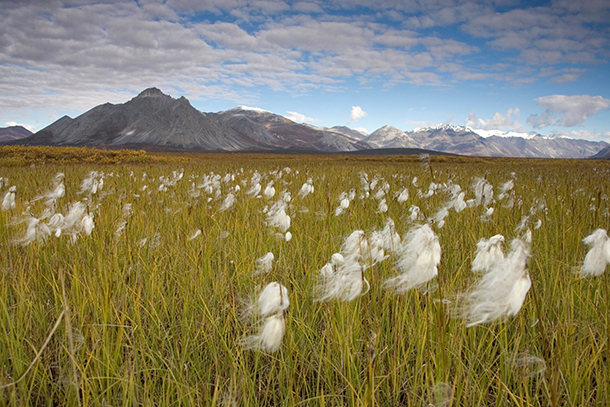
The Arctic National Wildlife Refuge (ANWR), shown above, represents the largest and wildest public in the United States. Proposals to allow oil leasing in the region have failed multiple times in the last several decades. (Photo: Alaska Region, U.S. Fish and Wildlife Service, Flickr CC BY-NC-ND 2.0)
President Trump has moved to open up America’s biggest and wildest protected area, the Arctic National Wildlife Refuge or ANWR, for oil drilling. Mr. Trump is also reviewing 27 National Monuments which are managed as national parks, to see if changes in size or status are necessary. Wilderness Society President, Jamie Williams, speaks with host Steve Curwood.
Transcript
CURWOOD: From PRI, and the Jennifer and Ted Stanley Studios at the University of Massachusetts Boston, this is Living on Earth. I’m Steve Curwood.
Republican-led Washington is looking to open up more of America’s public lands for development and fossil fuel extraction. President Trump has ordered a review of some 27 National Monuments protected over the last 30 years, including Grand Staircase Escalante in Utah, set aside by President Clinton and nearby Bear’s Ears, which was protected during the final weeks of the Obama Administration. June 10th is the deadline for Interior Secretary Ryan Zinke to send his recommendations to Mr. Trump. Also through his proposed budget, President Trump has signaled he wants to open up the iconic Arctic National Wildlife Refuge, in the far North Slope of Alaska, to oil and gas drilling, reigniting a controversy that has enflamed passions since 1977.
We’re joined now by Jamie Williams, the President of the Wilderness Society, to discuss the refuge and the potential threats to other protected natural areas. Welcome to Living on Earth, Jamie.
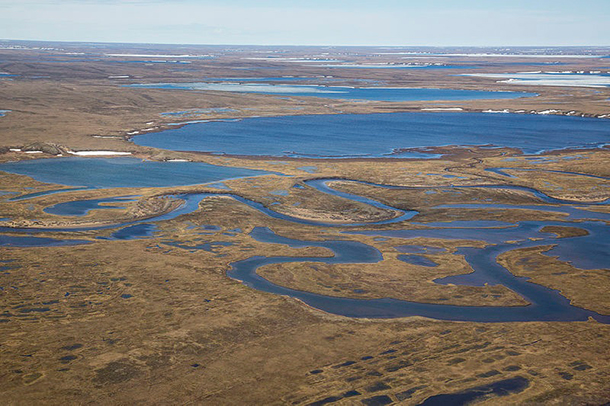
The National Petroleum Reserve is another federally-owned area with similar ecology near the ANWR. State and federal lawmakers have shown less interest in the region’s oil stores than in its more contested neighbor. (Photo: Bureau of Land Management, Wikimedia Commons CC BY 2.0)
WILLIAMS: Thank you. It’s great to be here.
CURWOOD: So, let's start off by having you describe the Arctic National Wildlife Refuge. Many people call it by its initials ANWR. Why is it important?
WILLIAMS: Well, the Arctic National Wildlife Refuge is the largest wildest place in all America. It's in northeastern Alaska, from the Brooks Range and descends down through the coastal plain to the Arctic Ocean, and it's truly America's Serengeti. The coastal plain is the biological heart of this amazing place where every June it explodes with life, where more than 180,000 caribou migrate every year to rear their young, where hundreds of birds species come, as well, to rear their young, and then migrate to every state in America and all over the world, and also where polar bears and many other wildlife depend on for their survival. So, it is a really important wild place for America and it's also really important to local native Alaskans who depend on caribou in particular for their food and for their culture, and so it's no accident that they call the coastal plain the sacred place where life begins.
CURWOOD: So, the president has put this in his budget. The budget is unlikely to go very far, given the present politics in Washington, but he sent the signal that he would like to open up the Arctic National Wildlife Refuge to oil and gas drilling. What would need happen exactly, though, for drilling there to become a real possibility?

The Gwich’in Nation, whose flag is above, is indigenous to Northern Canada and Alaska. The Gwich’in refer to the coastal plain of ANWR as “the sacred place where life begins”. (Photo: Xasartha, Wikimedia Commons CC BY-SA 3.0)
WILLIAMS: Well, like any park or protected public lands to open it up for drilling or development would require an Act of Congress, so that is essentially what President Trump is proposing by putting it in his budget to be taken to Congress, and we know that there are members in Congress who would like to see this happen as well. Senator Murkowski from the state of Alaska has introduced legislation that would also open up the refuge to drilling. So, in the 37 years that this refuge has been set up and protected, this is the most serious threat we've ever faced to opening it up for oil and gas drilling.
More importantly, we know that the majority of Americans do not want to see the Arctic National Wildlife Refuge developed. It's why this kind of proposal has been defeated in Congress multiple times over the past 37 years and why we believe it can be this time, but only if people really stand up and let their elected leaders know that they don't want to see America's wildest place drilled for the very last drop of oil at a time where there's plenty of oil in other places, and this is the most expensive place to drill.
CURWOOD: Now, next to the Arctic National Wildlife Refuge is similar land, but it's called the National Petroleum Reserve. Why isn't the the oil industry interested in doing extraction from there and pushing for opening up the Arctic National Wildlife Refuge?
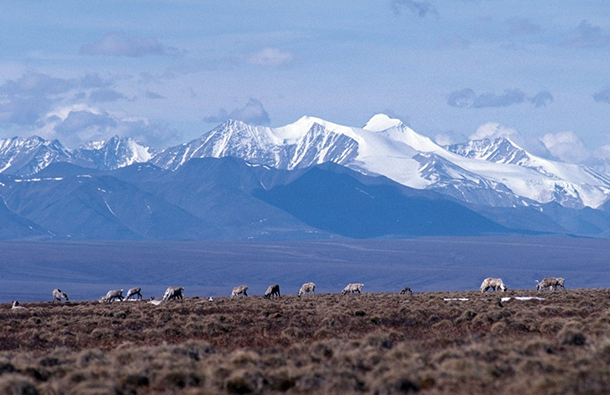
Caribou and their migrations are critical to ANWR’s ecosystems and to the livelihoods of indigenous communities in the area. Oil drilling could interfere with caribou migratory patterns and cause irreparable harm to the region, says The Wilderness Society’s Jamie Williams. (Photo: US Fish and Wildlife Service, Flickr CC BY 2.0)
WILLIAMS: Well, that's a very good question because this is really not about where the oil companies want to drill right now because it doesn't make economic sense to be drilling in the Arctic. It's about an ideological battle that's being waged by politicians that would like to open up our public lands to unfettered oil and gas development. One thing to recognize here is that over two-thirds of existing leases on our public lands that are held by oil companies are sitting idle and are not being drilled. That's more than 6,000 leases throughout the country that are not being utilized right now because the economics aren't there. What you see is political opportunism by politicians who see this as a symbolic victory to turn our public lands over to the oil and gas industry and the Arctic Refuge is the most symbolic of them all. It's the wildest biggest place in the country, and if they can open this up to oil and gas drilling, then what park in America is safe?
CURWOOD: Now, talk to me about what happened the last time that there was legislation in front of the Congress on opening the Arctic National Wildlife Refuge, ANWR.
WILLIAMS: Well, there was legislation in 2005 was the last time that we saw this battle which was defeated, and the reason was the American people spoke up across the country, as they have time and again, that they don't want to see their natural and cultural heritage compromised for industrial development particularly in the Arctic National Wildlife Refuge.
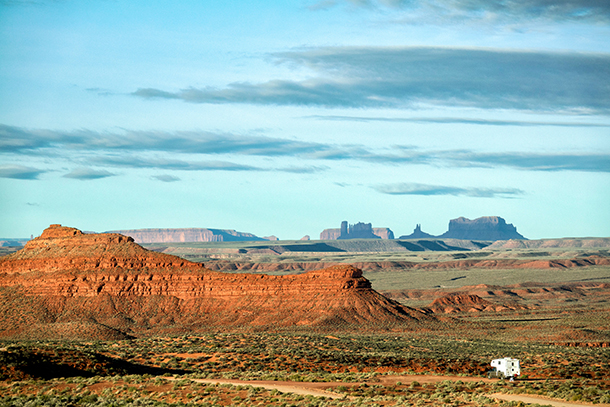
The distant spires of Monument Valley, as seen from the Valley of the Gods in Utah’s Bears Ears National Monument, currently under review by the Trump Administration. (Photo: John Fowler, Flickr CC BY 2.0)
CURWOOD: So, what's different over the question of drilling in the Arctic this time around, and why do proponents of this think that perhaps they have a chance?
WILLIAMS: Well, I think that proponents think that they have a chance this time because you have the alignment of extreme interest in the House with members of the Senate and now with the Trump administration, in trying to open up our public lands for unfettered oil and gas development. So, that political alignment between the three branches of government is I believe why they see that there's an opportunity. We still believe that politicians across the country will continue to hear from their constituents who care about this place and that they will stand up and do the right thing, but that will only happen if Americans recognize the threat we truly face and if they stand up and let their members know how much they care.
CURWOOD: Let's switch gears a bit here and talk about the National Monuments. The Trump administration is reviewing some National Monuments. There are a lot. Maybe you could mention just a few of particular concern.
WILLIAMS: Well, this is the first time in history that a president has proposed revoking or shrinking a National Monument. More than 150 have been established by presidents on both sides of the aisle that protect our natural and cultural heritage and tell America's story, and now we have an administration and a president who has called for the review of every National Monument established since 1996, more than 54 of them. So, they are looking from the Katahdin Woods and Waters in Maine to the Bears Ears National Monument in Utah to the California desert to the Cascades in Oregon, and many, many more.
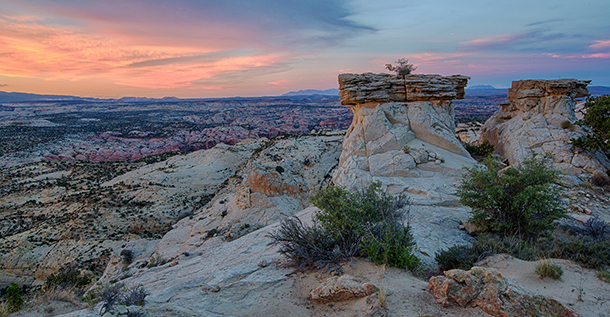
Grand Staircase-Escalante National Monument in Utah was designated by President Clinton in 1996, and is also under review. (Photo: Bob Wick / Bureau of Land Management, Flickr CC BY 2.0)
CURWOOD: And, Jamie, remind us of some areas that started as National Monuments that we now see as National Parks.
WILLIAMS: So, Acadia National Park started as a National Monument. The Grand Canyon was the first big National Monument established by Teddy Roosevelt in 1908. The Olympic National Park in Washington was also started as a National Monument. More than half of our National Parks started as National Monuments. This is essentially a first step to making a National Park is National Monument status.
CURWOOD: So, what does the law say about revoking a National Monument once it's been declared?
WILLIAMS: The Antiquities Act, which was passed by Teddy Roosevelt and Congress in 1906, gives the president the express authority to create a National Monument, to protect important places of natural, cultural, scientific, and historic qualities, but it does not give the president the authority to revoke a National Monument. Congress, of course, can do that, but the Antiquities Act does not give the president the authority to do that.
CURWOOD: Let's say that, for whatever reason, President Trump does say he wants to revoke one of these National Monuments. What would happen?
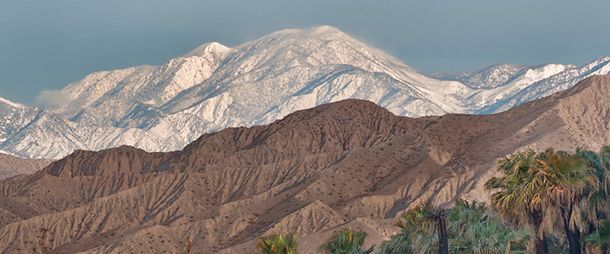
Sand to Snow National Monument, east of Los Angeles in California, is another of those under review by the Trump Administration. President Obama designated its 154,000 acres a National Monument in February 2016. (Photo: Bob Wick / Bureau of Land Management, Flickr CC BY 2.0)
WILLIAMS: Well, if the President we're to step forward and withdraw the protection of a National Monument with executive authority, I think what you will find is, they will go to the courts and that'll take many years to settle out.
CURWOOD: And let's just say at the end of the day that President Trump decides to revoke one of these National Monuments, it makes its way to the courts, and the courts finally say, “Well you can do it.” What would it mean for those areas if that status was revoked?
WILLIAMS: Well, what it would mean...it would mean losing the protections for these very special landscapes, landscapes that we love to go, to renew our spirit and soul, and in particular, in the case of Bears Ears in Utah, this is a sacred place to five tribes came together and actually proposed the creation of this National Monument. And what you're seeing right now is rock art, beautiful rock art that's tens of thousands of years old being shot off with guns, grave robbing of sacred sites and looting of a tremendous number of archaeological sites that exist throughout the Bears Ears region. So, without the protection, this kind of vandalism and looting will continue to proceed as it is now, which is really why the Antiquities Act was established in the first place.
CURWOOD: Now, proponents of looking again at these National Monuments, some of them think that the states should have more rights over this public land rather than the federal government. What's your response to that argument that the states should have more control of the land that they're part of?
WILLIAMS: Well, I think that there's a bigger agenda going on here, which is to transfer national lands that are owned by all Americans to the states so that they can be sold off to the highest bidder. If you look at Utah in particular, more than half of the lands that have already been transferred from the federal government to the state have been sold off.

Jamie Williams is president of the Wilderness Society. (Photo: Jamie Williams)
The states can't afford to manage all of these lands, to handle the cost of firefighting, let alone all the other costs, and the great thing about a National Monument is it provides a mechanism to protect these places for future generations but it also involves a development of a management plan. So, in Bear's Ears in Utah, for example, traditional uses of grazing and hunting will continue. The Native Americans who collect firewood and collect herbs there, things like that, those kinds of traditional uses will be allowed to continue while the resources of that incredible place are protected.
CURWOOD: Jamie, much of the federal land in the west was taken from Native Americans, and we don't have to go into that bloody and unfortunate history. But to what extent do the National Monuments take a step towards reparation to America's Native American community?
WILLIAMS: Well, Bears Ears is a really important step towards righting the wrongs that this country has inflicted upon the First Americans and the Native Americans of this country because it not only protects a place that five local tribes asked to be protected, that has huge importance to them, but in the proclamation it gives those tribes a seat at the table in the management of that monument going forward, and really sets a better precedent for recognizing tribes for the sovereign nations that they are and giving them an equal seat at the table with the US government in how these kinds of places that have such important historic significance to these tribes will be managed in the future.
CURWOOD: Jamie Williams is President of the Wilderness Society. Thanks so much for taking the time with me today, Jamie.
WILLIAMS: Thank you, Steve. I really appreciate it.
Links
CNN Money: “Trump wants to drill for oil in Alaska’s fragile wildlife refuge”
LA Times: “Here are the national monuments being reviewed under Trump's order”
Outside Magazine: “What Trump's Proposed Budget Means for Our Public Lands”
Explore the Bears Ears National Monument - from your computer
Living on Earth wants to hear from you!
Living on Earth
62 Calef Highway, Suite 212
Lee, NH 03861
Telephone: 617-287-4121
E-mail: comments@loe.org
Newsletter [Click here]
Donate to Living on Earth!
Living on Earth is an independent media program and relies entirely on contributions from listeners and institutions supporting public service. Please donate now to preserve an independent environmental voice.
NewsletterLiving on Earth offers a weekly delivery of the show's rundown to your mailbox. Sign up for our newsletter today!
 Sailors For The Sea: Be the change you want to sea.
Sailors For The Sea: Be the change you want to sea.
 The Grantham Foundation for the Protection of the Environment: Committed to protecting and improving the health of the global environment.
The Grantham Foundation for the Protection of the Environment: Committed to protecting and improving the health of the global environment.
 Contribute to Living on Earth and receive, as our gift to you, an archival print of one of Mark Seth Lender's extraordinary wildlife photographs. Follow the link to see Mark's current collection of photographs.
Contribute to Living on Earth and receive, as our gift to you, an archival print of one of Mark Seth Lender's extraordinary wildlife photographs. Follow the link to see Mark's current collection of photographs.
 Buy a signed copy of Mark Seth Lender's book Smeagull the Seagull & support Living on Earth
Buy a signed copy of Mark Seth Lender's book Smeagull the Seagull & support Living on Earth

